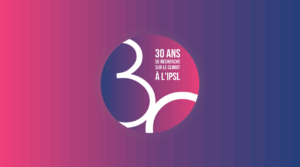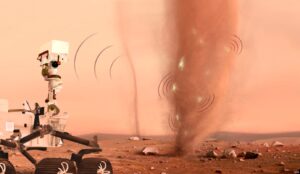Soutenance de HDR
Claudia Di Biagio
LISA
The radiative effects of absorbing aerosols
Résumé
Atmospheric aerosols are a key component of the climate system and major contributors to the Earth’s radiation budget. Understanding the role of aerosols in the radiative transfer of solar and infrared radiation in the atmosphere is crucial to understand their implication in past, present and future climate and climate changes. Currently, knowledge of the climatic properties of aerosols and their variability in link to varying emission sources and atmospheric ageing remains limited, particularly for natural and anthropogenic absorbing species such as mineral dust and carbonaceous aerosols containing black carbon (BC) and brown carbon (BrC). As a matter of fact, the spectral optical properties of aerosols, governing their direct interaction with radiation (scattering and absorption), as well as their ability to act as condensation nuclei for liquid (CCN) and ice (IN) clouds, are still largely unknown. Consequently, the representation of absorbing aerosols in climate models and satellite retrieval algorithms remains inadequate, which severely limits the ability to constrain their role in the radiation budget and its implications for regional and global climate.
My research activity over the last 15 years has been dedicated to study absorbing aerosols, their interactions with solar (SW) and infrared (LW) radiation and their direct radiative effect (DRE). The aim of my research is to quantify the intensity and spectral signature of aerosol absorption and scattering properties, such as the complex refractive index, and to understand their variability as a function of the emission source and atmospheric ageing of the particles. In particular, I aim to estimate how composition, size, shape and mixing state influence the aerosol absorption and scattering, and to produce parameterisations that describe this variability, so to provide usable informations to improve aerosol description in climate models and remote sensing algorithms. The methods I use in my research include experimental measurements in the CESAM large atmospheric simulation chamber (Chambre Expérimentale de Simulation Atmospherique Multiphasique) at LISA, which is my tool of predilection, as well as field observations, laboratory analytical techniques, analysis of ground-based and satellite remote sensing measurements, and regional and global models.
In my research I have set up original experiments in the CESAM chamber to study the spectral optical properties of mineral dust. These experiments have produced new information on the absorption properties and complex refractive index of global dust in the visible and mid-infrared range (0.4-15 µm), which paved the way for significant advances in the evaluation of the DRE and remote sensing of dust. I have subsequently developed a new line of research at CESAM on the study of the optical properties of BC and BrC, mostly looking at primary combustion emissions. I have also conducted studies aimed at investigating the optical and DRE properties of aerosols in mixing zones, where primary and secondary species, anthropogenic and biogenic, cohexist and interact. The results to date have highlighted the power of the laboratory simulation approach, and its synergy with field observations and modelling tools, to elucidate the processes and document the properties that are needed to understand the role of absorbing aerosols on the radiation budget and the climate system. In fact, the realism of aerosol generation and ageing that can be reproduced in a chamber, together with the controlled conditions that the laboratory can provide, are fundamental to producing relevant data for guiding the improvement of climate models and remote sensing algorithms.
My future research activity will be dedicated to further progress in the investigation of the climate-relevant properties of dust, BC, and BrC via the laboratory simulation approach. In particular, I will work to extend the spectral range of documented optical properties from the ultraviolet to the far infrared, including the study of key properties for remote sensing, such as polarisation. I will also work to improve the representation of the aerosol shape in the restitution of optical properties. I will strengthen the activity to study the link between optical properties, composition and mixing state. To do so, I will target both well-established dust sources but also encompass to emerging ones, such as dust from high latitude areas, and I will explore the range of formation pathways of BrC and the impact of ageing on the absorption of BC- and BrC-containing aerosols. Finally, I will extend my activity towards the study of the IN properties of dust, BC and BrC, which is particularly important for understanding the whole radiative effects of aerosols, particularly in polar environments. In order to make progress on all these subjects, the key aspect will be to design laboratory experiments reproducing increasingly realistic and complex conditions (humidity, mixture of species, multiphase chemistry, ageing time) representative of the diversity of situations encountered in the atmosphere.
Informations supplémentaires
Lieu
UPEC amphithéâtre MSE (bâtiment MSE, Campus central, Créteil)
Visio
https://cnrs.zoom.us/j/96001119152?pwd=rbz8NXLg9isJmcjTtav4FW5Egnacvg.1
Composition du jury
- Maria KANAKIDOU, Professeure, University of Créte (rapportrice)
- Spyros PANDIS, Professeur, University of Patras (rapporteur)
- Gordon MCFIGGANS, Professeur, University of Manchester (rapporteur)
- Cyrille FLAMANT, Directeur de Recherche, CNRS, LATMOS (examinateur)
- Stéphane SAUVAGE, Professeur, IMT-Nord Europe (examinateur)
- Bénédicte PICQUET-VARRAULT, Professeure, Université Paris Est Créteil, LISA (examinatrice)
- Paola FORMENTI, Directrice de Recherche, CNRS, LISA (examinatrice)





